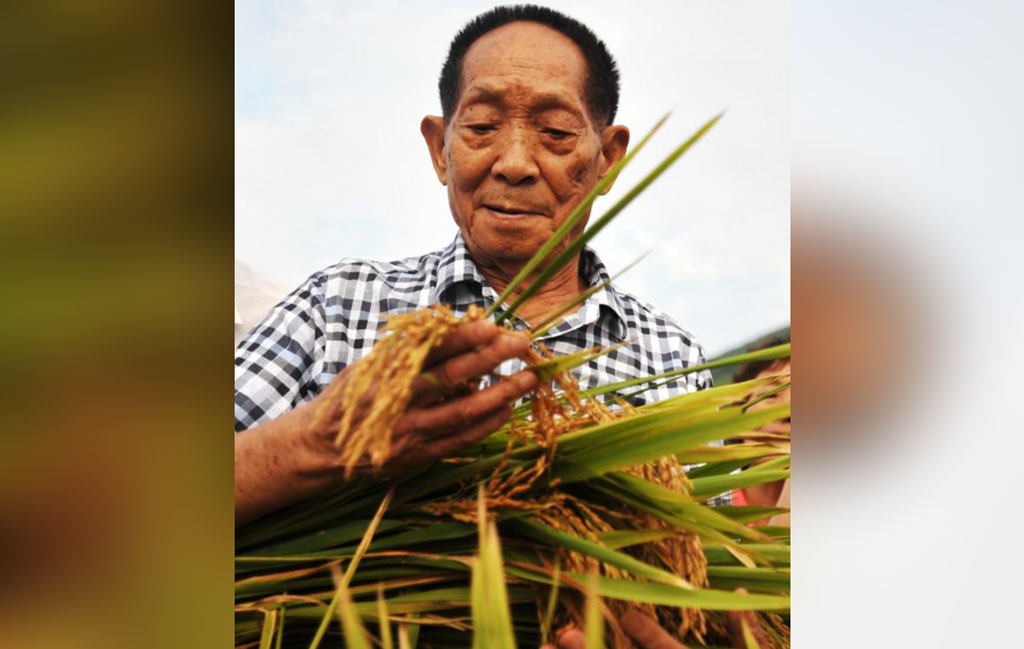The Father of Hybrid Rice, who passed away on May 22 this year, left behind a massive legacy of innovation to combat global food crisis
The world knows him as the Father of Hybrid Rice. His invention revolutionized the global hunger landscape in an era when an agricultural “green revolution” came as a rescue to mankind stalked by famines and acute food shortage in many parts of the world.
Thanks to Chinese agronomist Yuan Longping’s development of the first hybrid rice varieties in the 1970s, the world has witnessed millions of poor people lifted out of hunger. Hybrid rice varieties – with 20-30% higher yield potentials compared to their inbred counterparts – have ever since been grown in dozens of countries in Asia, Africa and America – boosting food security and diminishing the high risk of famines in many parts of the world.
Weeks after Longping’s demise (he died on May 22 this year at the age of 91), a galaxy of luminaries from the scientific fraternity was joined by the Chinese ambassador in Dhaka on Wednesday, celebrating his life and cherishing fond memories of the Father of Hybrid Rice. They noted that he had lived a simple life, leaving behind a great legacy.
Scientists, academics and farm sector entrepreneurs from Bangladesh, China and the Philippines joined the virtual commemoration held under the aegis of Bangladesh Seed Association (BSA).
The power of a person’s life is in the stories he or she leaves behind. When loved ones die, we tend to think about their legacy, about the meaning of their lives.
Dignitaries participating at Wednesday’s commemorative event recalled how Yuan Longping lived a modest life and would always dream of a day when not a single soul in this world would go without food. China’s envoy to Bangladesh Li Jiming said when many pundits in the West wrote books wondering “who will feed China?”, Yuan Longping gave the answer by not only enriching the food basket of China but also that of other countries.
He said that today 60% of China’s yearly rice output came from hybrid varieties and such hybrid rice varieties were also being grown on over eight million hectares of land in countries other than China. The ambassador, however, reminded all that the mission had not fully been accomplished yet as, in a world ravaged by the pandemic, still one in every eight people went to bed hungry.
Bangladesh rather started late in cultivating hybrid rice. Back in the late 1990s, when the government provided policy support to private seed companies in Bangladesh to go for hybrid rice seed imports, it earned the government lots of criticism. But fast forward to 2021, Bangladesh is growing an extra one million tons of rice – in most conservative estimates – from hybrid rice varieties each year. Some of the pioneers in introducing hybrid rice in Bangladesh also attended the Longping Commemoration event on Wednesday.
Among the world’s rice-growing nations, China alone grows hybrid rice on over 16 million hectares of land today, while it is also grown on eight million hectares of land elsewhere, including one million hectares in Bangladesh. Last year, China developed a new generation of hybrid rice with 14 tons of yield potential per hectare. Till the end of his life, Yuan Longping had a dream of taking this yield potential to up to 18 tons per hectare.
In an overpopulated country like Bangladesh, where land is scarce and three-fourths of all farmland are occupied by rice, high yield-potential hybrids can help grow more from less land, thereby releasing some land for other crops to be grown.
Dr. Jauhar Ali, who heads the Hybrid Rice Development Consortium at IRRI, Philippines, recalled how he worked closely with Yuan Longping, a World Food Prize laureate, when the latter helped introduce hybrid rice technology in India in the late 1980s. “He wouldn’t avail cars for the ride to the rice fields, neither would he stay in five-star hotels. I saw him always riding a bicycle and staying in the guestrooms of research stations,” he said. IRRI’s representative in Bangladesh, Dr Humanth Bhandary, said Longping was a pioneer of the green revolution and had also helped IRRI develop its hybrid rice research.
Chairperson of Longping Hi-Tec Seed company, Hefei, China, Ms Fan Ling; Vice Chairman of Winall Hi-tec Seed China, Jiang Sanqiao; President of China National Seed Association, Yanqiu Zhang; Secretary of Prof. Yuan Longping China National Hybrid Rice R&D Center, China, Dr Yang Yaosong also recalled Prof Yuan Longping’s contribution in lifting millions out of poverty and hunger.
Secretary-General of China Seed Trade Association Alison Wiehong Tian emphasized a furthering of cooperation between the farm sectors of Bangladesh and China for their mutual benefit.
Bangladesh Seed Association President Abdul Awal Mintoo; Managing Director of Lal Teer Seed Ltd Mahbub Anam; Chairman of Supreme Seed Md Masum; Chairman of Mollika Seed Company, FR Malik, Managing Director of ACI Seed Ltd Dr FH Ansarey; Sher e Bangla Agricultural University Vice-Chancellor Prof Shahidur Rashid Bhuiyan; Chairman of Bangladesh Krishi Bank Chairman Nasiruzzaman; former agriculture secretary Anwar Faruque; Vice-Chancellor of Bangladesh Agriculture University Prof Lutful Hasan; Country Head of HarvestPlus Bangladesh Khairul Bashar; Bangladesh Rice Research Institute’s Hybrid Rice Division head Dr Jamil Hassan Tushar, among others, also spoke at the event – all emphasizing the need for further increasing hybrid rice acreage in Bangladesh and pursuing frontier research.
What’s hybrid rice?
Hybrid rice is a type of Asian rice that has been crossbred from two very different parent varieties. Hybrid rice typically displays heterosis or “hybrid vigour,” so when grown under the same conditions as comparable inbred rice varieties, it can produce up to 30% more yield. To produce hybrid rice seed in a large quantity, an inbred sterile rice variety is fertilized with fertile pollen from a different variety. High-yielding rice, including hybrid rice, is one of the most important tools for combating global food crises.

